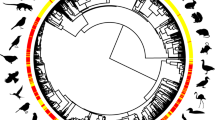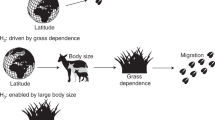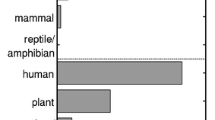Abstract
One could predict that the capacity for travelling great distances might predispose long-distance migratory birds to be good colonists and to exhibit wider geographic distributions than their non-migratory or short-distance migratory relatives or non-volant mammals. This prediction is not supported by the data on avian biogeography. The distributions of species, genera and families of North American and Eurasian birds and mammals are indeed related to migratory status, but long-distance migratory birds exhibit a great deal of biogeographic regionalism. In particular, at all taxonomic levels their distributions tend to be confined to either the Eastern or Western Hemisphere, suggesting that there has been little successful east–west dispersal between North America and Eurasia. Compared to non-migratory birds, short-distance migratory birds and non-volant mammals, long-distance migrants appear to be subject to severe constraints on their physiology, behaviour and ecology, w hich have prevented colonization of distant regions.
Similar content being viewed by others
References
Alerstam, T. (1979) Wind as selective agent in bird migration. Ornis Scand. 10, 76–93.
Begon, M., Harper, J.L. and Townsend, C.R. (1990) Ecology. Blackwell Scientific, Oxford.
Berthold, P. (1993) Bird Migration. Oxford University Press, Oxford.
Berthold, P. and Querner, U. (1981) Genetic basis of migratory behavior in European warblers. Science 212, 77–79.
Berthold, P., Mohr, G. and Querner, U. (1990) Steuerung und potentielle Evolutionsgeschwindigkeit des obligaten Teilzieherverhaltens: Ergebnisse eines Zweiweg-Selektionsexperiments mit der Mö nchsgrasmuÈ cke (Sylvia atricapilla). J. für Ornithol. 131, 33–45.
Berthold, P., Helbig, A.J., Mohr, G. and Querner, U. (1992) Rapid microevolution of migratory behaviour in a wild bird species. Nature 360, 668–670.
Bezzel, E. (1993) Kompendium der Vögel Mitteleuropas. Passeres-Singvögel. Aula Verlag, Wiesbaden.
Blondel, J. and Vigne, J.-D. (1993) Space, time, and man as determinants of diversity of birds and mammals in the Mediterranean region. In Species Diversity in Ecological Communities: Historical and Geographical Perspectives (R.E. Ricklefs and D. Schluter, eds), pp. 135–146. University of Chicago Press, Chicago, IL.
Böhning-Gaese, K. and Oberrath, R. (in press) Phylogenetic effects on morphological, life-history, behavioural and ecological traits of birds. Evol. Ecol. Res.
Brown, J.H. (1995) Macroecology. University of Chicago Press, Chicago, IL.
Brown, J.H. and Gibson, A.C. (1983) Biogeography. C.V. Mosby, St Louis, MO.
Curry-Lindahl, K. (1981) Bird Migration in Africa, Vol. 1. Academic Press, London.
Dixon, C. (1897) The Migration of Birds. Horace Cox, Windsor House, London.
Felsenstein, J. (1985) Phylogenies and the comparative method. Am. Nat. 125, 1–15.
Gill, F.B. (1989) Ornithology. W.H. Freeman, New York.
Hagan, J.M., Lloyd-Evans, T.L. and Atwood, J.L. (1991) The relationship between latitude and the timing of spring migration of North American landbirds. Ornis Scand. 22, 129–136.
Harvey, P.H. and Pagel, M.D. (1991) The Comparative Method in Evolutionary Biology. Oxford University Press, Oxford.
Helle, P. and Mö nkkönen, M. (1990) Forest successions and bird communities: Theoretical aspects and ractical implications. In Biogeography and Ecology of Forest Bird Communities (A. Keast, ed.), pp. 299–318. SPB Academic Publishing, The Hague.
Keast, A. (1980) Synthesis: Ecological basis and evolution of the Nearctic-Neotropical bird migration system. In Migrant Birds in the Neotropics: Ecology, Behavior, Distribution, and Conservation (A. Keast and E.S. Morton, eds), pp. 559–576. Smithsonian Institute Press, Washington, DC.
Levey, D.J. and Stiles, F.G. (1992) Evolutionary precursors of long-distance migration: Resource availability and movement patterns in Neotropical landbirds. Am. Nat. 140, 447–476.
Mayr, E. (1946) History of the North American bird fauna. Wilson Bull. 58, 1–68.
Moreau, R.E. (1972) The Palaearctic-African Bird Migration Systems. Head, London.
Peterson, R.T. (1980, 1990) A Field Guide to the Birds, 2 vols. Houghton Mifflin, Boston, MA.
Peterson, R.T., Mountfort, G. and Hollom, P.A.D. (1983) A Field Guide to the Birds of Britain and Europe. Collins, London.
Pianka, E.R. (1994) Evolutionary Ecology. Harper Collins, New York.
Rappole, J.H. and Tipton, A.R. (1992) The evolution of avian migration in the Neotropics. Ornitologia Neotropical 3, 45–55.
Rappole, J.H. and Warner, D.W. (1980) Ecological aspects of migrant bird behaviour in Veracruz, Mexico. In Migrant Birds in the Neotropics: Ecology, Behavior, Distribution, and Conservation (A. Keast and E.S. Morton, eds), pp. 353–393. Smithsonian Institute Press, Washington, DC.
Robbins, C.S., Bystrak, D. and Geissler, P.H. (1986) The Breeding Bird Survey: Its First Fifteen Years, 1965-1979. US Fish and Wildlife Service Resource Publication 157, Washington, DC.
Rosenzweig, M.L. (1996) Comment: Colonial birds probably do speciate faster. Evol. Ecol. 10, 681–683.
Schoener, T. and Schoener, A. (1983a) Distribution of vertebrates on some very small islands. I. Occurrence sequences of individual species. J. Anim. Ecol. 52, 209–235.
Schoener, T. and Schoener, A. (1983b) Distribution of vertebrates on some very small islands. II. Patterns in species number. J. Anim. Ecol. 52, 237–262.
Sclater, P.L. (1858) On the general geographical distribution of the members of the class Aves. J. Proc. Linn. Soc. (Zool.) 2, 130–145.
Sibley, C.G. and Monroe, B.L., Jr. (1990) Distribution and Taxonomy of Birds of the World. Yale University Press, New Haven, CT.
Sohonen, T. (1985) Agriculture and birdlife in Finland: A review. Ornis Fennica 62, 47–55.
Vaughan, T.A. (1986) Mammalogy, 3rd edn. W.B. Saunders, Philadelphia, PA.
Villard, M.-A. and Taylor, P.D. (1994) Tolerance to habitat fragmentation influences the colonization of new habitat by forest birds. Oecologia 98, 393–401.
Wallace, A.R. (1876) The Geographical Distribution of Animals, Vols 1 and 2. Macmillan, London.
Webb, S.D. (1991) Ecogeography and the Great American Interchange. Paleobiology 17, 266–280.
Wilson, D.E. and Reeder, D.M. (eds) (1992) Mammal Species of the World: A Taxonomic and Geographic Reference, 2nd edn. Smithsonian Institute Press. Washington, DC.
Winkler, H. and Leisler, B. (1992) On the ecomorphology of migrants. Ibis 134 (suppl. 1), 21–28.
Author information
Authors and Affiliations
Rights and permissions
About this article
Cite this article
Böhning-Gaese, K., González-Guzmán, L.I. & Brown, J.H. Constraints on dispersal and the evolution of the avifauna of the Northern Hemisphere. Evolutionary Ecology 12, 767–783 (1998). https://doi.org/10.1023/A:1006538414645
Issue Date:
DOI: https://doi.org/10.1023/A:1006538414645




